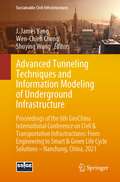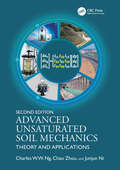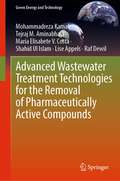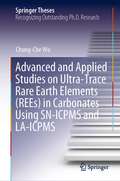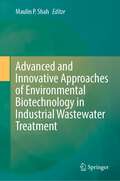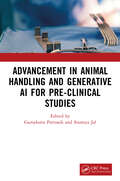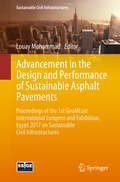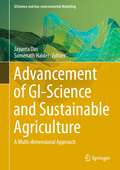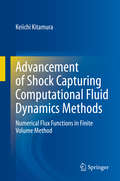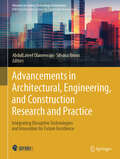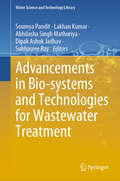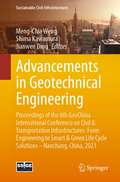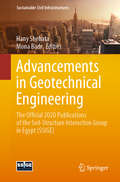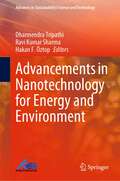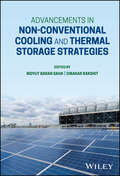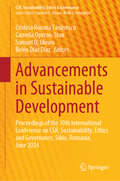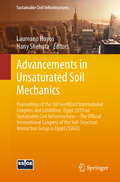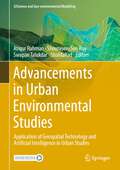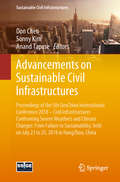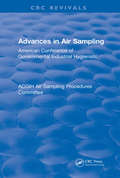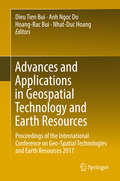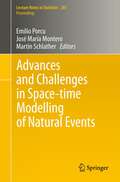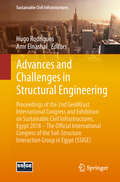- Table View
- List View
Advanced Transport Phenomena
by L. Gary LealAdvanced Transport Phenomena is ideal as a graduate textbook. It contains a detailed discussion of modern analytic methods for the solution of fluid mechanics and heat and mass transfer problems, focusing on approximations based on scaling and asymptotic methods, beginning with the derivation of basic equations and boundary conditions and concluding with linear stability theory. Also covered are unidirectional flows, lubrication and thin-film theory, creeping flows, boundary layer theory, and convective heat and mass transport at high and low Reynolds numbers. The emphasis is on basic physics, scaling and nondimensionalization, and approximations that can be used to obtain solutions that are due either to geometric simplifications, or large or small values of dimensionless parameters. The author emphasizes setting up problems and extracting as much information as possible short of obtaining detailed solutions of differential equations. The book also focuses on the solutions of representative problems. This reflects the book's goal of teaching readers to think about the solution of transport problems.
Advanced Treatment Technologies for Fluoride Removal in Water: Water Purification (Water Science and Technology Library #125)
by Vijay P. Singh Akhilesh Kumar Yadav Saba ShirinThis book presents an overview of the techniques available today for the removal of fluoride contamination/pollutants/species from water. Also covered are traditionally applied techniques for the removal of fluoride pollutants/species, including oxidation, coagulation-flocculation, and membrane techniques. Recently, progress has been made on the utility of various nanoparticles for the extraction of contaminants from water. Fluoride contamination is affecting water resources quality worldwide as a result of human activities, such as mining and pesticide use. Due to the high risk of fluoride exposure, specific water treatment processes are required to meet more severe water quality standards. A better understanding of currently available processes is necessary to develop economical, efficient, and effective methods for fluoride removal. Fluoride can either be coated, adsorbed using a wide range of both mineral and organic constituents or can be directly rejected by membrane processes, such as reverse osmosis and nanofiltration. Recent developments of submerged hybrid membrane systems, such as membrane bioreactors in wastewater treatment, provide alternative technologies for fluoride treatment.
Advanced Tunneling Techniques and Information Modeling of Underground Infrastructure: Proceedings of the 6th GeoChina International Conference on Civil & Transportation Infrastructures: From Engineering to Smart & Green Life Cycle Solutions -- Nanchang, China, 2021 (Sustainable Civil Infrastructures)
by Shuying Wang Wen-Chieh Cheng J. James YangThis volume contains a compilation of studies regarding novel technology of underground space development, behavior analysis and modelling of soils and underground infrastructure from the 6th GeoChina International Conference held in Nanchang, China from July 19 to 21, 2021. The scope of the studies covers both methodological and pragmatic solutions to critical issues, including soil arching and invert heaving, penetration resistance of mono-bucket foundations in silty soil, inception of debris avalanches, and novel infrastructure survey methods based on point cloud and image analysis. It is anticipated that this updated knowledge will lead to more resilient design, expedited inspection, timely maintenance and rehabilitation of underground infrastructure, and will be beneficial to both researchers and practitioners in the field.
Advanced Unsaturated Soil Mechanics: Theory and Applications
by Junjun Ni Charles W.W. Ng Chao ZhouUnsaturated soil is a three-phase material that is ubiquitous on the Earth’s surface and exhibits complex behaviour, which becomes more complex in response to the Earth’s changing climate and increasing engineering activities. This is because the former affects its moisture and temperature conditions significantly and the latter governs its stress state and suction condition. This book is designed to meet the increasing challenges of climate change and engineering activities by covering the mechanics and engineering of unsaturated soil in a logical manner. It comprises four major parts: Water retention and flow characteristics Shear strength and stiffness at various temperatures State-dependent elasto-plastic constitutive modelling Field monitoring and engineering applications This second edition uniquely covers fundamental topics on unsaturated soil that are not covered in other similar books, including: the state- dependency of soil- water retention behaviour and water permeability functions, such as dependence on engineering activities small strain stiffness considering the influence of wetting- drying cycles and recent suction history, such as that due to climate change suction effects on dilatancy and peak shear strength cyclic thermal effects on soil behaviour state- dependent elastoplastic constitutive modelling of monotonic and cyclic behaviour engineering applications such as the South-to-North Water Transfer Project; an earthen landfill cover system devoid of geomembrane in the Xiaping landfill, Shenzhen; and a 15-m-deep multi- propped excavation in Tianjin, China
Advanced Wastewater Treatment Technologies for the Removal of Pharmaceutically Active Compounds (Green Energy and Technology)
by Mohammadreza Kamali Tejraj M. Aminabhavi Lise Appels Raf Dewil Maria Elisabete V. Costa Shahid Ul IslamThis book reports on the treatment of waters and wastewaters with contaminants of emerging concern such as pharmaceutically active compounds. It shows how to prevent the contamination of the environment with such pollutants in the content of effluents. This book reviews various physico-chemical and biological methods that have been developed in order to deal with the polluted effluents. It also evaluates the already developed technologies regarding the sustainability criteria. The chapters discuss technical aspects and put the spotlight on the sustainability aspects of the water and wastewater treatment technologies.
Advanced and Applied Studies on Ultra-Trace Rare Earth Elements (Springer Theses)
by Chung-Che WuThis book provides two state-of-the-art quantitative techniques to determine ultra-trace rare earth elements (REEs) in natural carbonates using solution nebulization-inductively coupled plasma mass spectrometry (SN-ICPMS) and laser ablation-inductively coupled plasma mass spectrometry (LA-ICPMS) with respective applications were presented in this dissertation. These techniques were applied to natural carbonates, including corals and stalagmites, to understand volcano eruptions and the impacts on modern biosystem and paleoclimate regimes. In the first SN-ICPMS protocol, direct measurements for femtogram quantity carbonate samples without chemical separation steps can offer accurate and high-precision analysis (±1.9-6.5%, 2σ) with a high sample throughput of 8-10 samples/hr routinely. Application to modern Porites corals collected from South China Sea region, the anomalies of REE contents and Al/Ca ratios associated with micro-domain images, register modern coral reefs could be exacerbated by volcanic eruptions. In the second protocol, a high-sensitivity quantitative open-cell LA-ICPMS technique has been established to allow direct sampling on stalagmite surface in the atmospheric air. This technique improved limits of detection down to sub-ng/g range and promises analyses of carbonate REE profiles at the single digit parts-per-billion (ppb) levels. Application to a 15-cm stalagmite collected from East Timor reveals two peaks of REE contents by at least one order of magnitude, possibly due to volcanic ash preserved in stalagmite. Both improved SN-ICPMS and LA-ICPMS techniques highlight the high-sensitivity and high-temporal-resolution carbonate REE analyses for corals and stalagmites, with great potential to other natural carbonates such as travertine, tufa, and flowstone, benefit our understanding of paleoclimatic and paleoenvironmental dynamics.
Advanced and Innovative Approaches of Environmental Biotechnology in Industrial Wastewater Treatment
by Maulin P. ShahThis book discusses new and innovative trends and techniques in the removal of toxic and refractory pollutants by means of various microbial biotechnology processes from wastewater, both on the laboratory and industrial scales. The book also highlights the main factors contributing to the removal of toxic pollutants as well as recycling, environmental impact, and wastewater policies after heavy metal removal. In addition, it assesses the potential application of several existing bioremediation techniques and introduces new cutting-edge emerging technologies. This book significantly contributes to the wastewater treatment plant industry so that the treatment systems can serve better and more resiliently for the purpose. This book is designed for engineers, scientists, and other professionals who are seeking introductory knowledge of the principles of environmental bioremediation technology and for students who are interested in the environmental microbiology and bioremediation fields.
Advancement in Animal Handling and Generative AI for Pre-clinical Studies
by Gurudutta Pattnaik Soumya JalAYUSH encompasses traditional Indian medical systems like Ayurveda, Yoga, Naturopathy, Unani, Siddha, and Homeopathy. The CCRAS, funded by AYUSH, supports research programs to scientifically validate traditional medicine’s effi□cacy. India’s Ministry of AYUSH promotes and regulates these practices, aiming for their integration into modern healthcare while preserving their cultural signifi□cance. Centurion University of Technology and Management (CUTM), established in 2010, offers quality education across various fields. Noteworthy for its holistic approach, CUTM emphasizes practical skills, industry collaboration, and societal contributions. It’s School of Pharmacy and Life Sciences, along with the School of Paramedics and Allied Health Sciences, lead in providing quality healthcare educa□tion, maintaining robust ecosystems to bolster healthcare facilities.
Advancement in the Design and Performance of Sustainable Asphalt Pavements: Proceedings of the 1st GeoMEast International Congress and Exhibition, Egypt 2017 on Sustainable Civil Infrastructures (Sustainable Civil Infrastructures)
by Louay MohammadThis volume on "Advancement in the Design and Performance of Sustainable Asphalt Pavements" includes a collection of research and practical papers from an international research and technology activities on Mixture Design Innovation, Structural Pavement Design, Advancement in Production and Construction, Climate Changes and Effects on Infrastructure, Green Energy, Technology and Integration. The volume constitutes an important contribution in view of the urgent need to develop materials, designs, and practices to ensure the sustainability of transportation infrastructure. This volume is part of the proceedings of the 1st GeoMEast International Congress and Exhibition on Sustainable Civil Infrastructures, Egypt 2017.
Advancement of GI-Science and Sustainable Agriculture: A Multi-dimensional Approach (GIScience and Geo-environmental Modelling)
by Jayanta Das Somenath HalderThis book describes the contributing aspects of contemporary developments related to sustainable agricultural resources and assessment of sustainable agriculture in developing nations. The issues like food crisis and declining agro-productivity, post-pandemic food security, zonation and mapping technique viewing food crisis, biotechnology and sustainable agricultural, scaling hunger indices, health hazard and food crisis, changing climate and food availability, consumer load and fertilizer usage, growing demand and increasing usage of harmful chemical in agro-fields are regarded as serious concerns. Thereafter, the scope of sustainable agricultural potentiality (SAP) modeling, amidst the arena of deforestation and encroachment of new cultivable land, impact of pandemic on sustainable agriculture, using wastewater as non-sustainable agricultural practice, applying geospatial techniques on extreme weather susceptibility and agro-production, soil erosion and poor agricultural production, questioning shifting cultivation on the issue of sustainability, meteorological drought and irrigational gaps, occupational mobility and loss of agricultural heritage, farm-excreta burning and air quality index (AQI), GI-Science and sustainable agro-management, community preparedness in food crisis management, multi-criteria hunger index (MCHI), climate change declining sustainable agro-production are worth some. Almost the entire world has recently suffered from several natural and human-induced problems, among which food crisis and unsustainable agriculture throw significant challenges to human society. Contrastingly, if modern technology and means, with advanced monitoring and calibration methodology and policy guidance, can help, it will undoubtedly reduce half of the world's problems and ensure the future survival of human society. In addition, this approach also can minimize the other partially linked problems, like climate change and food shortage, livelihood crisis, environmental refugees, international trade balance, global food supply chain interruption, the ever-expanding gap between rich and poor, and so on. Therefore, properly nurturing the knowledge on the application of GI-Science for an agriculturally sustainable society and their monitoring and management can curtail the gap between science, policy, and the ground-level scenario concerned.
Advancement of Shock Capturing Computational Fluid Dynamics Methods: Numerical Flux Functions in Finite Volume Method
by Keiichi KitamuraThis book offers a compact primer on advanced numerical flux functions in computational fluid dynamics (CFD). It comprehensively introduces readers to methods used at the forefront of compressible flow simulation research. Further, it provides a comparative evaluation of the methods discussed, helping readers select the best numerical flux function for their specific needs.The first two chapters of the book reviews finite volume methods and numerical functions, before discussing issues commonly encountered in connection with each. The third and fourth chapter, respectively, address numerical flux functions for ideal gases and more complex fluid flow cases— multiphase flows, supercritical fluids and magnetohydrodynamics. In closing, the book highlights methods that provide high levels of accuracy.The concise content provides an overview of recent advances in CFD methods for shockwaves. Further, it presents the author’s insights into the advantages and disadvantages of each method, helping readers implement the numerical methods in their own research.
Advancements in Architectural, Engineering, and Construction Research and Practice: Integrating Disruptive Technologies and Innovation for Future Excellence (Advances in Science, Technology & Innovation)
by AbdulLateef Olanrewaju Silvana BrunoThis book offers a captivating discussion into the cutting-edge developments at the intersection of architecture, engineering, construction, and technology. With a focus on the power of big data analytics and computational design, this book delves into the transformative potential of these domains in shaping the built environment and business. This book discovers the fusion of architectural and engineering innovations with the capabilities of big data analytics, machine learning, and AI and explores how this parallelism is revolutionizing the design process, enhancing efficiency, and opening new horizons for creativity. This book steps into a world where predictive models, statistical algorithms, and what-if scenarios drive advancements in architectural and engineering practices and witnesses the seamless integration of technology in design generation, data visualization, task automation, and performance testing. It is an essential read for researchers and professionals seeking to leverage the potential of big data analytics to transform the built environment, maintaining the central role of humans.
Advancements in Bio-systems and Technologies for Wastewater Treatment (Water Science and Technology Library #118)
by Soumya Pandit Subhasree Ray Abhilasha Singh Mathuriya Lakhan Kumar Dipak Ashok JadhavThis book explains the main problems of industrial wastewater treatments and how they are being treated by innovative biological processes. The need for clean water in developing countries has become difficult to achieve as a result of globalization and industrialization and because of an increase in population, urbanization, and per capita water use. Residential, commercial, industrial, and educational institutions produce immense amounts of wastewater. Wastewater is treated to extract toxins to produce processed effluent by physical, chemical, and biological processes. Most of these innovative treatment systems are membrane filtration, advanced oxidation processes, and electrochemical approaches, which are strongly committed to offering solutions to help protect public health and the environment. For wastewater treatment, different forms of bioreactors are used which are reliable, cost-efficient, and effective in removing a wide variety of contaminants. This book outlines the capacity of various bioreactors that are most widely used for the treatment of different industrial and domestic wastewater, such as a rotating biological contactor, biological fluidized bed reactor, packed bed reactor, membrane bioreactor, continuous stirred tank bioreactor, up-flow anaerobic sludge blanket reactor, and photobioreactor, etc. Despite this, the acceptance of these technologies and their commercialization on an industrial scale, the performance is still limited. Therefore, a broader use of cost-effective in situ remedial approaches to natural phenomena like bioremediation is needed. The role of numerous bioreactors in industrial effluent treatment has, including recent developments, also been explored in depth. Furthermore, it includes the operational factors affecting their performances, advances in their architectural design, their amalgamation with the existing setup, scale-up studies, life cycle assessment of those reactors, materials and cost analysis, etc. This information helps the reader to understand the insight into the mechanism, pros and cons, moreover efficient utilization, and commissioning of bioreactors.
Advancements in Geotechnical Engineering: Proceedings of the 6th GeoChina International Conference on Civil & Transportation Infrastructures: From Engineering to Smart & Green Life Cycle Solutions -- Nanchang, China, 2021 (Sustainable Civil Infrastructures)
by Meng-Chia Weng Shima Kawamura Jianwen DingWith increasing urbanization and development of society, advancement in geotechnical technologies is essential to the construction of infrastructures. Geotechnical Investigation is the first step of applying scientific methods and engineering principles to obtain solutions to civil engineering problems. The studies presented in this volume deal with the attempts made by scholars and engineers to address the latest development in geotechnical engineering such as characterization of geomaterials, slope stability, tunneling, mitigation of geohazards, and some other geotechnical issues that are quite relevant in today's world. This volume is based on contributions to the the GeoChina International Conference on Civil & Transportation Infrastructures: From Engineering to Smart & Green Life Cycle Solutions -- Nanchang, China, 2021.
Advancements in Geotechnical Engineering: The official 2020 publications of the Soil-Structure Interaction Group in Egypt (SSIGE) (Sustainable Civil Infrastructures)
by Hany Shehata Mona BadrThis book intends directly the practical engineers, who will be of great interest in reading the interesting chapters. Earthwork projects are critical components in civil construction and often require detailed management techniques and unique solution methods to address failures. Being earthbound, earthwork is influenced by geomaterial properties at the onset of a project. Hence, an understanding of the in-situ soil properties and all geotechnical aspects is essential. Analytical methods for earth structures remain critical for researchers due to the mechanical complexity of the system. Striving for better earthwork project management, the geotechnical engineering community continues to find improved testing techniques for determining sensitive properties of soil and rock, including stress wave-based, non-destructive testing methods. To minimize failure during earthwork construction, past case studies and data may reveal useful lessons and information to improve project management and minimize economic losses.
Advancements in Nanotechnology for Energy and Environment (Advances in Sustainability Science and Technology)
by Dharmendra Tripathi Ravi Kumar Sharma Hakan F. ÖztopThis book presents a very useful and valuable collection of chapters associated with recent developments in energy, environment, and nanotechnology including nanofluids dynamics. The book provides insights related to various forms of nanotechnological applications in green buildings, environmental and electrochemical systems, solar distillation systems, green energy, storage tank of the solar water heating systems, solar concentrator system's receiver, solar adsorption refrigeration system, and CFD simulations of various aspects of nanofluids/hybrid nanofluids, which are particularly useful, valuable for the betterment of society, culture, and ultimately mankind.
Advancements in Non-Conventional Cooling and Thermal Storage Strategies
by Bidyut Baran Saha Dibakar RakshitAn exploration of the technical, economic, and energy-saving aspects of the design, modeling, and operation of non-conventional cooling and heating systems Cooling and heating can collectively constitute one of the largest sources of energy consumption in a modern building, with attendant costs and sustainability concerns. As the global climate changes and temperature extremes produce demand for even greater energy consumption, energy-efficient methods for cooling interior spaces have become more important than ever. Our sustainable future demands non-conventional methods for cooling and thermal storage which can meet the demands of a changing climate and an efficient, renewable power grid. Advancements in Non-Conventional Cooling and Thermal Storage Strategies offers a detailed introduction to the latest cutting-edge space conditioning technologies for buildings. Beginning with an overview of activated carbon-based adsorbents and their potential heating and cooling applications, it moves to an analysis of Phase Change Materials (PCMs) as a potential sustainable cooling source. Thorough, rigorous, and fully up to date, it’s indispensable for a range of professionals working to make habitable, energy-efficient human spaces. Advancements in Non-Conventional Cooling and Thermal Storage Strategies readers will find: Techniques for both active and passive space conditioning systemsDetailed discussion of topics including adsorbent-refrigerant pairings, techniques for incorporating fresh air at high air change per hour, and moreA composite case study with examples from across the globe to provide an understanding of technical requirements Advancements in Non-Conventional Cooling and Thermal Storage Strategies is ideal for researchers and professional mechanical and civil engineers, those working in space-cooling, HVAC, and building design industries, and research and design personnel of HVAC equipment manufacturing industry.
Advancements in Sustainable Development: Proceedings of the 10th International Conference on CSR, Sustainability, Ethics and Governance, Sibiu, Romania, June 2024 (CSR, Sustainability, Ethics & Governance)
by Samuel O. Idowu Belén Díaz Díaz Camelia Oprean-Stan Cristina Roxana TănăsescuThis book gathers selected contributions from the 10th Annual Conference of the Global Corporate Governance Institute, held in Sibiu, Romania on June 12 - 14, 2024. Its chapters present the work of internationally respected scholars and experts, focusing on corporate social responsibility, sustainability, ethics, corporate governance, finance, and responsible investing. In this context, it highlights the latest research findings on responsible action and their practical implications for business, society, science, and politics. The book pursues an integrated and multidisciplinary approach and equips readers with the knowledge they require for implementing holistic and effective sustainability strategies in organizations and educational institutions. Accordingly, it offers a valuable resource for academics, policymakers, business leaders, and sustainability practitioners who want to drive meaningful change for a sustainable future.
Advancements in Unsaturated Soil Mechanics: Proceedings of the 3rd GeoMEast International Congress and Exhibition, Egypt 2019 on Sustainable Civil Infrastructures – The Official International Congress of the Soil-Structure Interaction Group in Egypt (SSIGE) (Sustainable Civil Infrastructures)
by Hany Shehata Laureano HoyosThis book presents the collection of technical papers which includes research on two important topics in geotechnical engineering; the characterization of unsaturated soils. The papers in this collection are representative of local challenges facing geotechnical engineers in the Middle East, but their contributions can also be extended to other regions of the world.
Advancements in Urban Environmental Studies: Application of Geospatial Technology and Artificial Intelligence in Urban Studies (GIScience and Geo-environmental Modelling)
by Shouraseni Sen Roy Atiqur Rahman Swapan Talukdar ShahfahadAccording to UN estimates, approximately nearly half of the world's population now lives in cities and that figure is expected to rise to almost 70% by 2050. Cities now account for around 70% of worldwide greenhouse gas emissions, and this percentage is predicted to rise in the near future as a result of projected increases in global urbanization patterns. It is widely acknowledged that irrational urban planning and design can increase emissions while also exacerbating threats and risks, resulting in a slew of environmental issues such as urban heat islands, air pollution, flooding, amongst other issues, as well as environmental, social, and economic losses. Therefore, these concerns must be addressed promptly in order to cope up with these rising difficulties and make urban environments safer for residents. With the advancement of remote sensing technology and the use of current remote observation systems, urban data science, remote sensing, and artificial intelligence (AI), modeling and quantifying emergent difficulties in urban regions and urban systems have become easy. They aid in the quantitative analysis of urban shape, functions, and human behavior in cities. Harvesting data, developing models, and suggesting new methodologies will be aided by combining urban ecology with new breakthroughs in data science. This book is of great value to a diverse group of academicians, scientists, students, environmentalists, meteorologists, urban planners, remote sensing and GIS experts with a common interest in geospatial sciences within the earth environmental sciences, as well as human and social sciences.
Advancements on Sustainable Civil Infrastructures: Proceedings of the 5th GeoChina International Conference 2018 – Civil Infrastructures Confronting Severe Weathers and Climate Changes: From Failure to Sustainability, held on July 23 to 25, 2018 in HangZhou, China (Sustainable Civil Infrastructures)
by Don Chen Sonny Kim Anand TapaseThis book presents recent advances in the field of geomaterial and waste management. With high urbanization rates, advancement in technologies, and changes in consumer behavior, wastes generated through the daily activities of individuals and organizations pose many challenges in terms of their management. The studies presented in this book highlight attempts on the part of researchers and practitioners to address contemporary issues in geoenvironmental engineering such as the characterization of dredged sediments, geomaterials and waste, valorization of waste, sustainability in waste management, and various other geoenvironmental issues that are becoming increasingly relevant in today’s world. The studies were selected from papers presented at the 5th GeoChina International Conference, Civil Infrastructures Confronting Severe Weathers and Climate Changes: From Failure to Sustainability, held in Hangzhou, China on July 23–25, 2018.
Advances In Air Sampling: American Conference of Governmental Industrial Hygienists (CRC Press Revivals)
by American Conference of Governmental Industrial HygienistsA copublication of the American Conference of Governmental Industrial Hygienists and Lewis Publishers, this series continues the former Annuals of the American Conference of Governmental Industrial Hygienists. This series is designed to present state-of-the-art information on research and practical applications of science in the field of occupational health. Bokos are normally the proceedings of an important symposium or conference sponsored by the ACGIH or other leading professional organization in, or allied with, the occupational health field. Content deals with subject of current interest. Books in the Industrial Hygiene Science Series should become valued additions to the international scientific literature. Published volumes in this series are: Microcomputer Applications in Occupational Health and Safety Ergonomic Interventions to Prevent Musculoskeletal Injuries in Industry Advances in Air Sampling.
Advances and Applications in Geospatial Technology and Earth Resources: Proceedings of the International Conference on Geo-Spatial Technologies and Earth Resources 2017
by Dieu Tien Bui Anh Ngoc Do Hoang-Bac Bui Nhat-Duc HoangThis book discusses the latest advances and applications in geospatial technologies and earth resources for mine surveying and civil engineering. It also discusses mineral resources management and assesses many techniques such as unmanned aerial vehicles/drones, ground-penetrating radar, geographic information system (GIS) and GIS-based machine learning. The book gathers the proceedings of the International Conference on Geo-Spatial Technologies and Earth Resources (GTER 2017), which was co-organized by the Hanoi University of Mining and Geology (HUMG) and the International Society for Mine Surveying (ISM) and held in Hanoi, Vietnam, on October 5-6, 2017. GTER 2017 is technically co-sponsored by the Vietnam Mining Science and Technology Association (VMST), Vietnam Association of Geodesy, Cartography and Remote Sensing (VGCR), Vietnam National Coal-Mineral Industries Holding Corporation Limited (VINACOMIN), and the Dong Bac Corporation (NECO). The event is intended to bring together experts, researchers, engineers, and policymakers to discuss and exchange their knowledges and experiences with modern geospatial technologies, recent advances in mining and tunneling, and the geological and earth sciences. Given its breadth of coverage, the book will appeal to scientists in the field as well as professionals interested in related technological applications.
Advances and Challenges in Space-time Modelling of Natural Events (Lecture Notes in Statistics #207)
by José–maría Montero Emilio Porcu Martin SchlatherThis book arises as the natural continuation of the International Spring School "Advances and Challenges in Space-Time modelling of Natural Events," which took place in Toledo (Spain) in March 2010. This Spring School above all focused on young researchers (Master students, PhD students and post-doctoral researchers) in academics, extra-university research and the industry who are interested in learning about recent developments, new methods and applications in spatial statistics and related areas, and in exchanging ideas and findings with colleagues.
Advances and Challenges in Structural Engineering: Proceedings of the 2nd GeoMEast International Congress and Exhibition on Sustainable Civil Infrastructures, Egypt 2018 – The Official International Congress of the Soil-Structure Interaction Group in Egypt (SSIGE) (Sustainable Civil Infrastructures)
by Hugo Rodrigues Amr ElnashaiThis edited volume on challenges in structural and bridge engineering brings together contributions to this important area of engineering research. The volume presents findings and case studies on fundamental and applied aspects of structural engineering, applied to buildings, bridges and infrastructures in general, and heritage patrimony. The scope of the volume focuses on the application of advanced experimental and numerical techniques and new technologies to the built environment. The volume is based on the best contributions to the 2nd GeoMEast International Congress and Exhibition on Sustainable Civil Infrastructures, Egypt 2018 – The official international congress of the Soil-Structure Interaction Group in Egypt (SSIGE).


